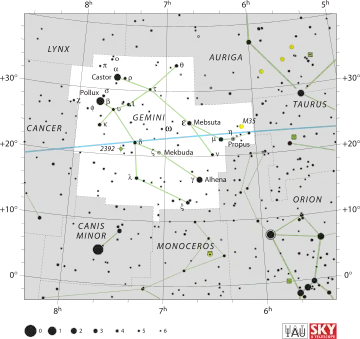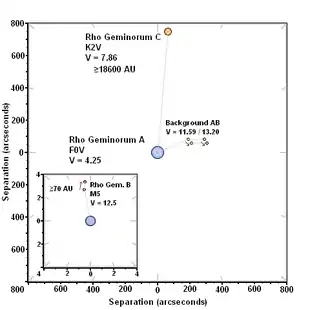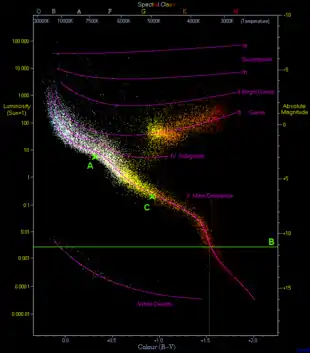Rho Geminorum
Rho Geminorum (ρ Gem) is a star system that lies approximately 59 light-years away in the constellation of Gemini, about 5 arcminutes east of Castor. The system consists of a primary bright enough to be seen with the naked eye, a faint secondary which has rarely been observed even professionally, and a distant, somewhat bright tertiary which requires telescopic equipment for observation.

| |
| Observation data Epoch J2000.0 Equinox J2000.0 | |
|---|---|
| Constellation | Gemini |
| ρ Gem A | |
| Right ascension | 07h 29m 06.719s ± 2.72[1] |
| Declination | +31° 47′ 04.38″ ± 2.72[1] |
| Apparent magnitude (V) | 4.2473 ± 0.003[1] |
| ρ Gem B | |
| Right ascension | 07h 29m 06.0s[2] |
| Declination | +31° 46′ 56″[2] |
| Apparent magnitude (V) | 12.50[3] |
| ρ Gem C | |
| Right ascension | 07h 29m 01.769s ± 11.24[1] |
| Declination | +31° 59′ 37.84″ ± 6.41[1] |
| Apparent magnitude (V) | 7.74[3] |
| Characteristics | |
| ρ Gem A | |
| Spectral type | F1V[4] |
| B−V color index | 0.320 ± 0.012[1] |
| ρ Gem B | |
| Spectral type | M5 |
| ρ Gem C | |
| Spectral type | K2.5V[4] |
| B−V color index | 0.923 ± 0.018[1] |
| Variable type | BY Dra[5] |
| Astrometry | |
| ρ Gem A | |
| Radial velocity (Rv) | −3.70 ± 0.7[6] km/s |
| Proper motion (μ) | RA: 159.09 ± 0.31[1] mas/yr Dec.: 193.29 ± 0.18[1] mas/yr |
| Parallax (π) | 55.41 ± 0.24[1] mas |
| Distance | 58.9 ± 0.3 ly (18.05 ± 0.08 pc) |
| Absolute magnitude (MV) | 2.9639[7] |
| ρ Gem B | |
| Absolute magnitude (MV) | 11.217[7] |
| ρ Gem C | |
| Radial velocity (Rv) | −3.95 ± 0.1[8] km/s |
| Proper motion (μ) | RA: 157.85 ± 1.28[1] mas/yr Dec.: 175.95 ± 0.73[1] mas/yr |
| Parallax (π) | 56.63 ± 0.93[1] mas |
| Distance | 57.6 ± 0.9 ly (17.7 ± 0.3 pc) |
| Absolute magnitude (MV) | 6.5787[7] |
| Details | |
| ρ Gem A | |
| Mass | 1.355 ± 0.013[9] M☉ |
| Radius | 1.655 ± 0.028[9] R☉ |
| Luminosity | 5.542 ± 0.089[9] L☉ |
| Surface gravity (log g) | 4.11 ± 0.03[10] cgs |
| Temperature | 6899 ± 63[9] K |
| Metallicity [Fe/H] | -0.25 ± 0.04[10] dex |
| Rotational velocity (v sin i) | 59.0 ± 3.0[11] km/s |
| Age | 2.1 ± 0.2[9] Gyr |
| ρ Gem C | |
| Mass | 0.77[12] M☉ |
| Surface gravity (log g) | 4.71 ± 0.08[10] cgs |
| Temperature | 4948 ± 41[10] K |
| Other designations | |
| ρ Gem A: 62 Gem, BD+32° 1562, HD 58946, HIP 36366, Gliese 274A, HR 2852 | |
| ρ Gem B: Gliese 274 B | |
| ρ Gem C: HIP 36357, BD+32° 1561, Gliese 273.1, V376 Gem | |
| Database references | |
| ρ Gem A | |
| SIMBAD | data |
| ρ Gem B | |
| SIMBAD | data |
| ρ Gem C | |
| SIMBAD | data |
Components


Rho Geminorum A is a bright star with a spectral type F0V, meaning that it is a main sequence that is over a thousand kelvins hotter, one-third more massive, two-thirds larger and five-and-a-half times more luminous than the Sun. With an apparent magnitude of 4.25, it is approximately the seventeenth-brightest star in the constellation of Gemini. Though there are some sources indicating that the star is a spectroscopic binary, including the Washington Double Star Catalog (WDS) and the Gliese Catalogue of Nearby Stars, no orbit has been provided.
The WDS lists four companions to Rho Geminorum. Of these, surprisingly little is known about the closest companion, the magnitude 12.5 Rho Geminorum B. The most recent measurement lists a separation of 3.4 arcseconds, corresponding to a separation perpendicular to the line of sight of approximately 85 AU. The spectral type listed in SIMBAD is M5, though this is without a source; Plotting the star's absolute magnitude on the Hertzsprung-Russell diagram (see left) indicates a B-V of 1.53, a value closer to that of an M3V star.[13] Peculiarly, the five observations recorded in the WDS date between 1910 and 1935 and none have been made since; even in literature, more recent attempts to resolve Rho Geminorum B have been unsuccessful.[14] The measurements listed in the WDS seem to be inconsistent with the star being in the background, so the reasons for the failure to observe Rho Geminorum B is unclear.
The next-closest companion, the magnitude 11.59 WDS 07291+3147 C, had a much larger separation of 211.6 arcseconds in 1886. However, this separation increased by 10 arcseconds by 2001, indicating that it is a background star that is unrelated to Rho Geminorum. Correcting for Rho Geminorum A's proper motion, this star's proper motion is RA = -19 mas/yr and Dec = -55 mas/yr. This is a modestly large value, consistent with a distance of a few hundred light-years. WDS 07291+3147 C is itself listed as having a companion, the magnitude 13.20 WDS 07291+3147 D. Relative to WDS 07291+3147 C its separation has remained at about 100 arcseconds between 1909 and 2001, indicating similar proper motion. While this would indicate that the two stars are bound, at a large distance this separation would indicate a separation of at least several thousand AU and their mutual separation has not been entirely consistent (the position angle has increased from 267 to 270°, and the separation has decreased from 104.1 to 102.3 arcseconds). It is therefore possible that the two background stars are bound, but it is not certain.
The final companion in the WDS, the magnitude 7.86 WDS 07291+3147 E (Rho Geminorum C), has a larger still separation of 756 arcseconds, translating to a separation perpendicular to the line of sight of about 18600 AU. The position of this star relative to the primary has remained consistent over decades, indicating that it has a common proper motion and is therefore a wide tertiary component. The wide separation has also facilitated for observations without contamination from Rho Geminorum A, and as of such Rho Geminorum C has its own Gliese catalogue number (273.1) and Hipparcos catalogue number (36357). The Hipparcos parallax is consistent with that of the primary to 1σ, leading to a probability that they are bound of approximately 100%.[12] The star is also known to be a BY Draconis variable with a period of 11.63 days, caused by varying brightness as starspots move across the stellar surface across its rotation period. While the derived age for Rho Geminorum A of 2.1 billion years is not excessively young, Rho Geminorum C is still very active: It has an S'HK of about 0.5,[15] a value similar to that of the near-analogous Epsilon Eridani whose Log R'HK is -4.45. This is much higher than a "quiet" value of <-4.8, making Rho Geminorum C bizarrely active for a modestly old star.
The Rho Geminorum system is an interesting look into a system architecture similar to the 40 Eridani system while the most massive component is on the main sequence, before becoming a white dwarf.
References
- van Leeuwen, F. (2007). "Validation of the new Hipparcos reduction". Astronomy and Astrophysics. 474 (2): 653–664. arXiv:0708.1752. Bibcode:2007A&A...474..653V. doi:10.1051/0004-6361:20078357. S2CID 18759600.
- Dommanget, J.; Nys, O. (2002). "VizieR Online Data Catalog: CCDM (Catalog of Components of Double & Multiple stars) (Dommanget+ 2002)". VizieR On-line Data Catalog: I/274. Originally Published in: Observations et Travaux 54. 1274. Bibcode:2002yCat.1274....0D.
- Tokovinin, A. A. (1997). "MSC - a catalogue of physical multiple stars". Astronomy and Astrophysics Supplement Series. 124 (1): 75–84. Bibcode:1997A&AS..124...75T. doi:10.1051/aas:1997181. ISSN 0365-0138.
- Gray, R. O.; Corbally, C. J.; Garrison, R. F.; McFadden, M. T.; Robinson, P. E. (2003). "Contributions to the Nearby Stars (NStars) Project: Spectroscopy of Stars Earlier than M0 within 40 Parsecs: The Northern Sample. I". The Astronomical Journal. 126 (4): 2048–2059. arXiv:astro-ph/0308182. Bibcode:2003AJ....126.2048G. doi:10.1086/378365. ISSN 0004-6256. S2CID 119417105.
- Samus, N. N.; Durlevich, O. V.; et al. (2009). "VizieR Online Data Catalog: General Catalogue of Variable Stars (Samus+ 2007–2013)". VizieR On-line Data Catalog: B/GCVS. Originally Published in: 2009yCat....102025S. 1: 02025. Bibcode:2009yCat....102025S.
- Gontcharov, G. A. (2006). "Pulkovo Compilation of Radial Velocities for 35 495 Hipparcos stars in a common system". Astronomy Letters. 32 (11): 759–771. arXiv:1606.08053. Bibcode:2006AstL...32..759G. doi:10.1134/S1063773706110065. ISSN 1063-7737. S2CID 119231169.
- The relevant calculation for absolute magnitude is , where is the apparent magnitude and is the distance in light-years. The distance was assumed to be 58.9 light-years, derived from the parallax of Rho Geminorum A.
- Nidever, David L.; Marcy, Geoffrey W.; Butler, R. Paul; Fischer, Debra A.; Vogt, Steven S. (2002). "Radial Velocities for 889 Late‐Type Stars". The Astrophysical Journal Supplement Series. 141 (2): 503–522. arXiv:astro-ph/0112477. Bibcode:2002ApJS..141..503N. doi:10.1086/340570. ISSN 0067-0049. S2CID 51814894.
- Boyajian, Tabetha S.; et al. (2012). "Stellar Diameters and Temperatures. I. Main-sequence A, F, and G Stars". The Astrophysical Journal. 746 (1): 101. arXiv:1112.3316. Bibcode:2012ApJ...746..101B. doi:10.1088/0004-637X/746/1/101. S2CID 18993744.
- Wu, Yue; et al. (2011). "Coudé-feed stellar spectral library - atmospheric parameters". Astronomy & Astrophysics. 525: A71. arXiv:1009.1491. Bibcode:2011A&A...525A..71W. doi:10.1051/0004-6361/201015014. S2CID 53480665.
- Ammler-von Eiff, M.; et al. (2012). "New measurements of rotation and differential rotation in A-F stars: are there two populations of differentially rotating stars?". Astronomy & Astrophysics. 542: A116. arXiv:1204.2459. Bibcode:2012A&A...542A.116A. doi:10.1051/0004-6361/201118724. S2CID 53666672.
- Shaya, Ed J.; Olling, Rob P. (January 2011), "Very Wide Binaries and Other Comoving Stellar Companions: A Bayesian Analysis of the Hipparcos Catalogue", The Astrophysical Journal Supplement, 192 (1): 2, arXiv:1007.0425, Bibcode:2011ApJS..192....2S, doi:10.1088/0067-0049/192/1/2, S2CID 119226823
- A Modern Mean Stellar Color and Effective Temperatures (Teff) # Sequence for O9V-Y0V Dwarf Stars, E. Mamajek, 2011, website
- Hartkopf, William I.; et al. (2009). "Speckle Interferometry at Mount Wilson Observatory: Observations Obtained in 2006-2007 and 35 New Orbits". The Astronomical Journal. 138 (3): 813–826. Bibcode:2009AJ....138..813H. doi:10.1088/0004-6256/138/3/813.
- Isaacson, Howard; et al. (2010). "Chromospheric Activity and Jitter Measurements for 2630 Stars on the California Planet Search". The Astrophysical Journal. 725 (1): 875–885. arXiv:1009.2301. Bibcode:2010ApJ...725..875I. doi:10.1088/0004-637X/725/1/875. S2CID 118577960.